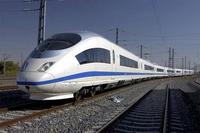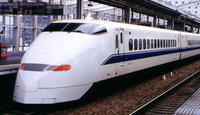-
DHS interested in systems for covert body scans
DHS has signed contracts for the development of mobile and static systems that can be used scan pedestrians and people at rail and bus stations and special event venues — apparently at times without their knowledge; DHS moved to develop the technology as part of an effort to bolster the ability of law enforcement personnel to quickly detect concealed bombs and other explosives on individuals
-
-
Maryland wants Florida's high speed rail funds

As Republican governors in Florida, Wisconsin, and Ohio reject federal funding for high speed rail projects, states like Maryland are clamoring to receive those funds; Maryland Senators Benjamin L. Cardin and Barbara A. Mikulski sent a letter to Transportation Secretary Ray LaHood requesting that $2.4 billion dollars in high speed rail funding originally designated for Florida be redirected to projects in the Northeast Corridor; each year 250 million rail passengers use the corridor and passenger use is projected to increase by 60 percent by 2030; the White House plans to spend $53 billion on high speed rail projects over the next six years and $8 billion in the coming fiscal year alone
-
-
Border bottlenecks hamper trade
Last year, U.S. exports to Mexico totaled $163 billion, and imports from Mexico totaled $229.6 billion; nearly 80 percent of that trade crosses through land border ports on trucks and railcars; the 1.8-million strong Border Trade Alliance says bottlenecks at border crossings hamper this trade and make it more costly to grow it; the Alliance urges Congress and the Obama administration to invest in border ports of entry, including hiring more staff; Obama’s proposed 2011 budget includes only 300 new Customs and Border Protection officers, while Republicans propose shrinking the Border Patrol by 870 agents
-
-
Studying wait times at modified truck fast lane
Western Washington University has received $49,000 to conduct field research on wait times and lane reconfiguration at the U.S.-Canada border; the university’s Border Policy and Research Institute will collect and analyze data on wait times as part of a pilot to examine alternative use of the dedicated Free and Secure Trade truck lane at the Blaine crossing
-
-
High-speed derailment

Sophisticated high-speed commercial trains such as France’s TGV, Japan’s Bullet trains, and China’s Shanghai Maglev that travel up to 311 mph are leaving the United States in the dust; this week, President Obama proposed a 127 percent increase on public transit spending to create jobs and stimulate the economy despite Republican plans to reduce the $1.5 trillion deficit; Republican lawmakers, governors say the development of high-speed rail should left for the private market
-
-
Russia spending $1.6 billion to bolster transportation security
The Russian government announced that it would spend about $1.6 billion over the next three years to beef up transportation security; roughly $410 million will be spent on increasing metro security; Transportation Minister Igor Levitin says the metro is the weakest link in security efforts; there are 300 entrances in the Moscow metro alone; last year two female suicide bombers detonated bombs in Moscow’s busy metro system killing forty people and injuring more than 100; Moscow has the second busiest subway system in the world, second only to Tokyo
-
-
Dramatic expansion of DC surveillance camera network
Washington, D.C. is proposing a plan that would add thousands of surveillance camera feeds from local businesses to the city’s homeland security agency existing command center; the city already monitors more than 4,500 cameras placed in its public transportation system and schools; critics say that this is a poor use of resources and violates civil liberties; cities like New York, London, and Baltimore already employ this practice
-
-
United States susceptible to Moscow-style bombing
The TSA has invested $212 million to train hundreds of Behavioral Detection Officers (BDOs) in the Screening of Passengers by Observation Techniques (SPOT) program; the program is supposed to train security personnel to notice suspicious behavior by people in crowds, but lawmakers and academics question its value
-
-
China Looks to Invest in California's High Speed Rail
China looks to add California’s extensive high-speed rail project to its resume; with experience in rail projects both at home and throughout Asia, China can also bring financing to the table as well as project expertise
-
-
N.Y.-N.J. PATH tunnels bomb-proofed
If a small explosive — with enough power to blast a 50-foot hole in a tunnel — were detonated, more than a million gallons of Hudson River water per minute would surge into the PATH tubes; the Port Authority is hardening the tubes against terrorist attacks — placing water-absorbing pads around the tunnels, ringing the inside of the tunnels with blast-resistant steel, and building huge floodgates to seal off a tunnel in case water comes gushing in after a blast
-
-
GPS system keep track of busses
When we think of the Transportation Security Administration, we usually think of their work done to protect air travel; they are also involved, however, in other forms of transportation, like charter buses; DHS administers a grant to help charter companies install GPS tracking systems in their coaches — and Trailways used to money to equip its 2,000 buses with GPS
-
-
Senator Udall calls on Napolitano to consider TTCI's rail security contributions
Senator Mark Udall (D-Colorado) calls on DHS to consider the Transportation Technology Center Inc. (TTCI) when making decisions on how best to carry out the DHS mission; TTCI conducts research and tests on track, locomotives, rail cars, and other rail equipment
-
-
Securing rails: doable, if complicated, endeavor
For a long time, the primary concern when it came to rail security was people wanting to steal a freight train’s contents, shoot the crew or rob the passengers; the U.S. post-9/11 focus on security, however, is shining a new spotlight on other hazards surrounding railroads; the desire to protect the railroads, their employees, and passengers must be balanced by what can really be done given that rail is used to move large numbers of people and large quantities of goods; railroad security — whether for passenger rails, commuter lines, or freight trains — is thus a complicated endeavor
-
-
Napolitano says scanners may be used for trains, subways, and boats
DHS secretary Janet Napolitano says that full-body scanners may be deployed in train stations, on subway platforms, and in marinas; experts point out that terrorists would not necessarily need to board a train to do damage: train graffiti is one indication how easy it to access parked trains — and trains roll on miles and miles of exposed track in open landscapes
-
-
U.K. railways threatened by changes in rainfall patterns
Some of the U.K.’s railway infrastructure was built in the nineteenth century on unprepared foundations, before engineers understood soil mechanics; rail embankments are structures made of soil and rock, which are always be affected by climate — particularly rainfall patterns
-
- All
- Regional
- Water
- Biometrics
- Borders/Immig
- Business
- Cybersecurity
- Detection
- Disasters
- Government
- Infrastructure
- International
- Public health
- Public Safety
- Communication interoperabillity
- Emergency services
- Emergency medical services
- Fire
- First response
- IEDs
- Law Enforcement
- Law Enforcement Technology
- Military technology
- Nonlethal weapons
- Nuclear weapons
- Personal protection equipment
- Police
- Notification /alert systems
- Situational awareness
- Weapons systems
- Sci-Tech
- Sector Reports
- Surveillance
- Transportation
Advertising & Marketing: advertise@newswirepubs.com
Editorial: editor@newswirepubs.com
General: info@newswirepubs.com
2010-2011 © News Wire Publications, LLC News Wire Publications, LLC
220 Old Country Road | Suite 200 | Mineola | New York | 11501
Permissions and Policies
Editorial: editor@newswirepubs.com
General: info@newswirepubs.com
2010-2011 © News Wire Publications, LLC News Wire Publications, LLC
220 Old Country Road | Suite 200 | Mineola | New York | 11501
Permissions and Policies
